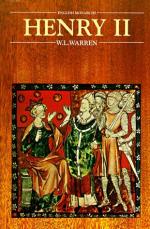The king’s harsh mood was marked too by the cruel prosecutions of offences against forest law which had been committed in the time of the war. The severe punishments were perhaps a means of chastizing is affected landowners; they were certainly useful in filling the empty treasury. Nobles and barons everywhere were sued for hunting or cutting wood or owning dogs, and were fined sometimes more than their whole possessions were worth. In vain the justiciar, De Lucy, pleaded for justice to men who had done these things by express orders of the king given to De Lucy himself; “his testimony could prevail nothing against the royal will.” Even the clergy were dragged before the civil courts, “neither archbishop nor bishop daring to make any protest.” The king’s triumph over the rebellion was visibly complete when at York the treaty which had been made the previous year with the King of Scotland was finally concluded, and William and his brother did homage to the English sovereigns. A few weeks later Henry and his son received at Windsor the envoys of the King of Connaught, the only one of the Irish princes who had till now refused homage.
In the Church as in the State the royal power was unquestioned. A papal legate arrived in October, who proved a tractable servant of the king; “with the right hand and the left he took gifts, which he planted together in his coffers”. His coming gave Henry opportunity to carry out at last through common action of Church and State his old scheme of reforms. In the Assize of Northampton, held in January 1176, the king confirmed and perfected the judicial legislation which he had begun ten years before in the Assize of Clarendon. The kingdom was divided into six circuits. The judges appointed to the circuits were given a more full independence than they had before, and were no longer joined with the sheriffs of the counties in their sessions, their powers were extended beyond criminal jurisdiction




